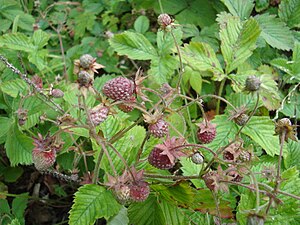Musk strawberry
| Musk strawberry | ||||||||||||
|---|---|---|---|---|---|---|---|---|---|---|---|---|

Musk strawberry fruits ( Fragaria moschata ) |
||||||||||||
| Systematics | ||||||||||||
|
||||||||||||
| Scientific name | ||||||||||||
| Fragaria moschata | ||||||||||||
| L. |
The musk strawberry ( Fragaria moschata ), also called cinnamon strawberry or muskrat , is a species of strawberry ( Fragaria ) within the rose family (Rosaceae). It often thrives on the edges of the forest, but also in damp bushes.
description

Vegetative characteristics
The musk strawberry is an evergreen , perennial, herbaceous plant . It reaches heights of up to 40 centimeters and is therefore larger than the garden strawberry .
The leaves are divided into a petiole and a leaf blade. The leaf blade, which is fingered in three parts, is pinnate and has a serrated leaf margin .
Generative characteristics
The musk strawberry blooms from May to June and the fruits ripen over the course of summer. The musk-strawberry is dioeciously separated ( dioecious ); male and female flowers occur on separate individuals. In culture also plant specimens found with hermaphrodite flowers, but it is suspected that there are hybrids with the hill-strawberry is. In contrast to the similar-looking forest strawberry , the cinnamon strawberry has horizontally protruding hairs on the flower stalks and the bracts are 5 to 10 millimeters in length larger than those of the related species.
The flowers are radial symmetry and five-fold. Each flower is surrounded by five small outer sepals. An alternating circle is formed by the actual five sepals . Above it are five white petals .
The "dummy fruit" is not a berry , as the name suggests, but a nut fruit .
The number of chromosomes is 2n = 42, but also 28, 35 or 56.
Possibility of confusion
It can be confused with the somewhat smaller forest strawberry . But while in the forest strawberry the hairs on the flower stalk are directed towards the flower, the hairs in the musk strawberry are protruding and point towards the root.
Occurrence
The musk strawberry grows preferentially along the edges of the forest and needs moist and protected locations, as it cannot tolerate strong temperature fluctuations, especially night frosts, especially in late spring. It thrives on nutrient-rich soils . It grows in Central Europe in companies of the associations Pruno-Rubion Carpinion or Alno Ulmion .
Use as food
The musk strawberry was cultivated in Germany in the past, but is now relatively rare to find in gardens, as it has been largely displaced by the cultivated varieties of the garden strawberry due to the greater cultivation effort and the smaller fruits.
The cinnamon or musk strawberry has been cultivated in parts of Europe for a long time; its cultivation has been secured since the early 17th century (illustration in the Hortus Eystettensis as fraga fructu magno ). At the beginning of the 19th century it was the strawberry most frequently found in the garden in Germany. Up until the First World War, the Vierlande near Hamburg were their main growing area, which is why they were often called " Vierlander Strawberries". Currently it is only cultivated in Italy, in the area around Milan, to a significant extent as "Profumata di Tortona ". Otherwise it can be found occasionally with lovers. Musk strawberries are characterized by a characteristic sweet and aromatic taste, comparable to the "nutmeg" taste of some grape varieties. Their cultivation is little different from that of other garden strawberries, but it is necessary to plant male or hermaphrodite plants as pollinators in addition to female.
- 'Capron' royal, hermaphrodite
- 'Bauwens', female
- 'Profumata di Tortona', female
- 'Asking' ('Truedsson') hermaphroditic
- 'Marie Charlotte (Hans)' bisexual
- 'Cotta', male
literature
- Dietmar Aichele, Marianne Golte-Bechtle: What is blooming there? Wild flowering plants of Central Europe . 54th edition. Franckh-Kosmos, Stuttgart 1991, ISBN 3-440-05615-5 , pp. 79 .
- Schlosser, Reichhoff, Hanelt et al .: "Wild Plants Central Europe", DLV 1991, ISBN 3-331-00301-8
Individual evidence
- ^ Georg August Pritzel , Carl Jessen : The German folk names of plants. New contribution to the German linguistic treasure. Philipp Cohen, Hannover 1882, page 154. ( online ).
- ↑ Günter Staudt : Les dessins d ' Antoine Nicolas Duchesne pour son Histoire naturelle des fraisiers. Museum of Nat. d'histoire Naturelle , Paris, 2003.
- ↑ a b Erich Oberdorfer : Plant-sociological excursion flora for Germany and neighboring areas . 8th edition. Verlag Eugen Ulmer, Stuttgart 2001, ISBN 3-8001-3131-5 . Page 543.
- ^ Manfred A. Fischer, Karl Oswald, Wolfgang Adler: Excursion flora for Austria, Liechtenstein and South Tyrol . 3rd, improved edition. Province of Upper Austria, Biology Center of the Upper Austrian State Museums, Linz 2008, ISBN 978-3-85474-187-9 , p. 487 .
- ↑ Brigitte Wachsmuth: Of monthly, forest and musk strawberries. In: Gartenpraxis , Volume 35, No. 4, 2009 pp. 20–28.
Web links
- Fragaria moschata Duchesne ex Weston, cinnamon strawberry. In: FloraWeb.de.
- Profile and distribution map for Bavaria . In: Botanical Information Hub of Bavaria . }
- Musk strawberry . In: BiolFlor, the database of biological-ecological characteristics of the flora of Germany.
- Fragaria moschata at Plants For A Future
- Distribution in the northern hemisphere.
- Thomas Meyer: Data sheet with identification key and photos at Flora-de: Flora von Deutschland (old name of the website: Flowers in Swabia )


